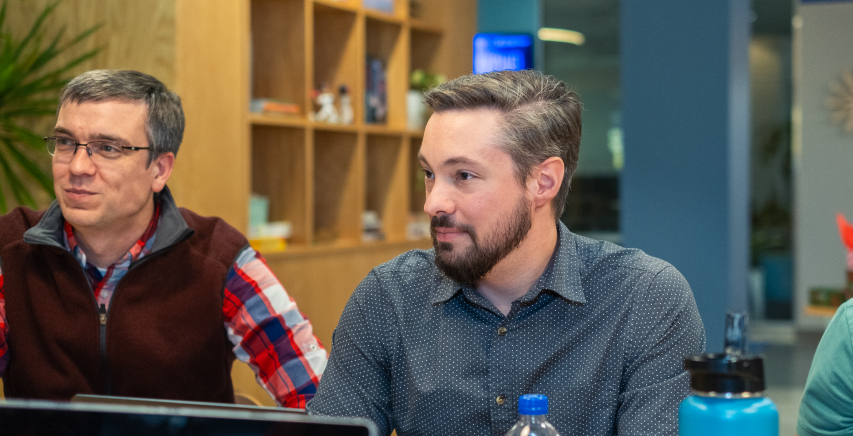As a web-first marketing and design company, we often encounter clients who need website and ongoing marketing support and want to go through a Request for Proposal (RFP) process as they are looking for the best website partner. But many don’t know how to write an RFP … and the task can be pretty daunting.
Have no fear! Classic City can help. We asked our team members and collaborators what information they need from companies crafting an RFP. We’ve pulled together their insights into a comprehensive guide to understanding and optimizing the RFP process.
The Importance of the RFP Process
An RFP is a document that organizations use to solicit bids from potential vendors for a specific project or service. One of the reasons to use an RFP is to make sure that each proposal is based on the same information so you can effectively and efficiently compare proposals from those different vendors. It can also help your organization to articulate exactly what you’re looking for, so you’re aligned and clear about expectations.
One thing to keep in mind, though: RFPs can sometimes overlook crucial insights and innovative solutions that experienced third-party contractors can offer.
Key Questions for Crafting an Effective RFP
Is this a Redesign or a New Website?
Understanding whether the project is a redesign or a brand-new website is crucial. For a redesign, focus on addressing pain points and improving functionality. For a new website, spend time in the initial visioning stages, setting realistic expectations. Claude Ball, one of our web designers, really emphasized this point. It’s true in relationships … and in web development—clear, realistic expectations are essential.
Feature Set
If your current website has any unique structures or code that you would like to keep, make a note of it so they aren’t missed. Also, if there are any unique features from competitors’ websites that you would like to have on your site, add those in as well with a link to reference.
SEO Transition
We always assume that transitioning SEO is a priority for most businesses, however, there are edge-cases where it is not important. A solid SEO transition strategy takes time to execute. If transitioning your SEO is not a business case that needs to be accounted for, that should be noted.
If you are creating a new website (and not replacing an old one), knowing whether or not SEO will play a vital role in your business’ success is key. All websites we build have the foundation for a solid SEO strategy, but not all organizations need a strategy created and implemented. Let agencies know whether or not creating that strategy is key.
Content Management System (CMS)
If you currently have a website, make a note of the current CMS (or overall tech stack) your website is on and if you have a preference towards staying or switching. A lot of agencies specialize in a particular CMS. Knowing this information up front will save you a lot of time from talking with the wrong agencies.
Timeline
The project timeline significantly impacts the design and development process. A rushed timeline may compromise creativity and thoroughness, while a more extended timeline allows for in-depth exploration and innovation. Claude noted that having sufficient time can lead to more “outside the box” thinking and a better final product.
I wanted to give a few examples of how long you can expect various parts of the process to take:
- Messaging Workshop: If your brand message is going to change, allow for ~2 months for an agency to collaborate with you to come up with that updated message
- Rebranding: If you’re looking for a new logo (and thus an entirely new aesthetic), plan for about 2 months. Typically rebranding and messaging can be tagged together and take about 3 months in total.
- Go to Market Strategy: A solid GTM plan of attack takes about 2-3 months to go from ideation to execution. If you’re looking for this, you should chat with Garrett.
- Website Design and Development: We have found that most agencies that build custom WordPress sites take between 4-5 months for a build.

When looking at that list, if you’re wondering: “What is the right order to do these in?”
- GTM Strategy → know your ideal customers and how you best serve them
- Messaging → take that core messaging and apply it across all mediums
- Branding → now you can build a visual aesthetic around your message
- Website → the website can use that aesthetic and tie everything together
Scope and Functionality
Clarifying the project scope and functionality helps in resource planning and setting realistic expectations. Provide detailed information about the number of pages, types of content (images, video, charts, etc.), and desired functionality (what will users need to be able to do on each page?).
- Content: How many pages/posts are going to be needed to launch the site (and, if you have a current website, how much of the content is reusable)?
- Calls to action: how are you defining “success” when a customer visits the website? What types of actions can a potential customer take?
- Languages: Should the website be multilingual?
- eCommerce: Do you need the ability to sell anything on the website?
- CRM: What CRM are you using and how are you using it?
Security Considerations
Security is critical, especially for projects involving sensitive data or requiring integrations with existing systems. Understanding your security requirements helps web development teams plan and allocate appropriate resources. Daniel pointed out that knowing the level of security needed can significantly affect the project timeline and necessary resources.
- Personally identifiable data: Is there any data that is being collected that would require extra security efforts?
- Server concerns: does the server the website will live on require anything unique to ensure it is not compromised?
- Protocols: are there any in-house systems that should be noted that would require a lengthier launching process?
Success Metrics
Defining measurable metrics for success ensures alignment between your expectations and the development team’s deliverables. Establish clear goals that are specific, measurable, and relevant to the project’s overall objectives. Daniel stressed the importance of agreeing on success metrics upfront to ensure everyone is aligned.
More Traffic
Everyone wants more traffic. However, simply building a new website without a marketing strategy in place will not automatically bring in new visitors. In order to have “increased traffic” as a success metric for the new website will require updates to your current marketing strategy as well.
Increasing Conversions
Some questions to consider when adding this as a success metric:
- What does a successful conversion look like? (it could be anything from signing up for a newsletter to purchasing something for $10,000)
- What type of content on the site will push people towards a conversion?
- What marketing efforts are going on to drive people to the website to convert?
Timing of the Launch
Sometimes, a simple success metric is launching on a specific date and time. Knowing what this is ahead of time will ensure scope does not increase in order to meet that deadline.
Company Vision and Market Perception
Understanding your company’s long-term vision and desired market perception provides valuable context for the project. This insight helps create a website that supports future growth and aligns with strategic goals. Brent McDowell, one of our strategists, shared that knowing the company’s vision can offer deep insights into your culture and strategic thinking. Some things to take into consideration:
- Long-term plan: What is the company’s 3/5/10 year plan? It doesn’t have to be in-depth, but knowing where you want to head will be key in building a website that is structured to last a long time.
- Customer perception: This goes hand-in-hand with the GTM strategy I talked about earlier. Understanding how your current customers perceive you in the market and why they continue to choose you will help define the sitemap and wireframes for the new website.
- Company culture: Why does your team like working at your company? What do you all value? Having a site that showcases those points will also help potential customers make that emotional connection with your brand before they even fill out a contact form or give you a call.
Budget
Clearly stating your budget range helps set realistic expectations and ensures that proposals are within your means. It also allows for better planning and prioritization of features and functionalities. Some organizations don’t like to share their budget because they want to see what their project would cost without that context. But if you’re willing to share your budget, your potential partners can shape their recommended approach to fit your constraints. Otherwise, you can end up with proposals for amazing websites that you have no hope of being able to afford.
How to avoid getting overcharged
When you’re going through the vetting process, lean on the agency’s past experiences. Don’t be afraid to ask for recommendations who you can have a conversation with. Looking up the agency on Clutch.co also gives you an idea of how expensive their previous projects were, the length of the engagement, as well as a very detailed report from their clients on what it’s like working with them.
Budget ranges
Building a new website has a lot of similarities to remodeling your house: there are a lot of companies that can do it and you won’t really know the quality of their work until after the work has been completed. But who should you go after? (Note: all of these budget numbers are based on a new website, within WordPress, 10-20 pages of written content, a moderate amount of SEO work start-to-finish)
- Freelancer: Less than $10,000 (probably using a pre-built template)
- Agency of 2-5 people: $10,000 – 25,000 (probably have a niche type of client they work with and probably will only focus on the website; you will get a custom site tailored to your specific needs)
- Agency of 5-15 people: $25,000 – 50,000 (will have multiple expert-level individuals across each discipline you need; you won’t just get a website)
- Large agency: $50,000+
Integration with Existing Systems
Providing detailed information about existing platforms and systems that need to integrate with the new website is crucial. The more information provided, the better the proposal can address these needs. Luke Maslow from APG Emerging Tech highlighted that insights into existing technology are vital to proposing the best solutions.
- Current systems: This is a good time to take an audit of your current technology stack (CRM, email marketing, intranet, etc.). Make a list of all the pieces that would need to integrate with your website and ask yourself: “is this truly needed?”
- Depth: How deep should you go in explaining these systems? As much as logically possible. Perhaps reaching out to the stakeholder who controls that system to get an overview would help guide that description.

User Experience & Customer Journey
Describing the user experience in detail—specifically what is referred to as the user journey— ensures that the website meets the needs of your users. One of the things I like to ask in my initial calls with customers is: “Describe your sales process to me once you have a call.” Luke added that the website should be tailored to help sales people close sales quicker.
- First steps: How do your users move from knowing very little (or nothing) about what you do to making a buying decision or responding to a call to action on your site?
- Questions customers ask: A common thing that is missing from websites are key questions that customers ask (especially on the B2B side). The more you can drive potential customers back to the website (and sending them less PDFs via email), the better.
- Customer feelings: This connects back to the “culture” side of what I talked about earlier: what do you want a customer to feel as they are going through the website? Whether your website is a primary driver to bring in new leads or simply just a backdrop to confirm to a referral you are a real company, you need your website to exude that culture.
Why Now?
What was the pain point that caused you to begin the process to design and build a new website at this point in your company’s development? Tell the story of what brought you to the place of preparing and sending out the RFP. This context will guide potential partners in understanding the problems that need to be solved as a part of the project.
Streamlining the RFP Process
Who Should Be Involved
- Primary Stakeholders: Include individuals who requested the project or solution and prominent team members.
- Executives: Ensure a company executive is involved for final approval, especially for high-cost projects. Make sure everyone is clear about who gives final approval at every step of the project.
- Procurement Team: A procurement team member will review the request, help distribute the RFP, and work with vendors.
- Other Stakeholders: Consider including IT, legal, and financial reviewers as needed.
Typical RFP Timeline
- Creating an RFP: 1-2 weeks
- Internal Approval: 1-2 weeks
- Collecting Proposals: 2-3 weeks
- Reviewing Proposals: 1-2 weeks
- Interviewing Agencies: 1-2 weeks
- Final Selection and Contracting: 1-2 weeks
Use Your RFP as a Tool to Find a Partner
By adopting a proactive and tailored approach, you can prepare an RFP that will help to ensure you get the best possible website tailored to your goals. Ultimately, remember that an RFP is a tool to accomplish your ultimate goal—to find a partner you can trust to help you build your business.

